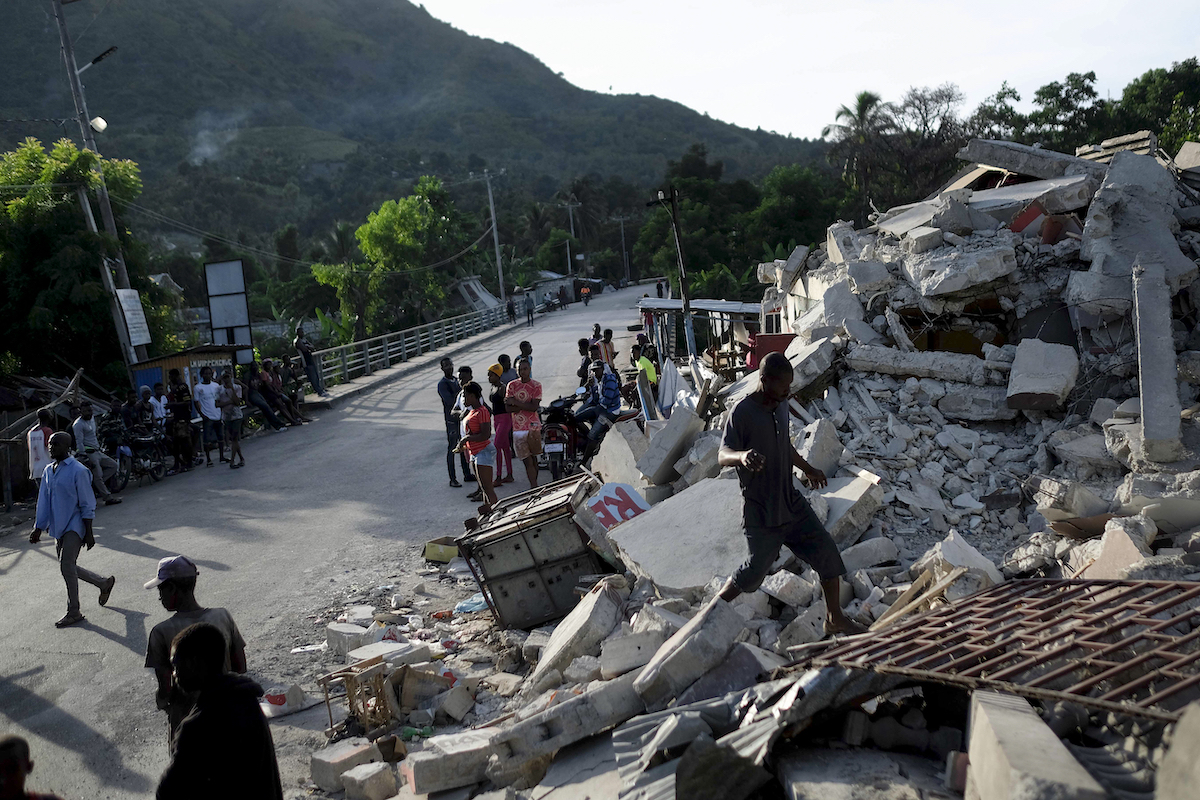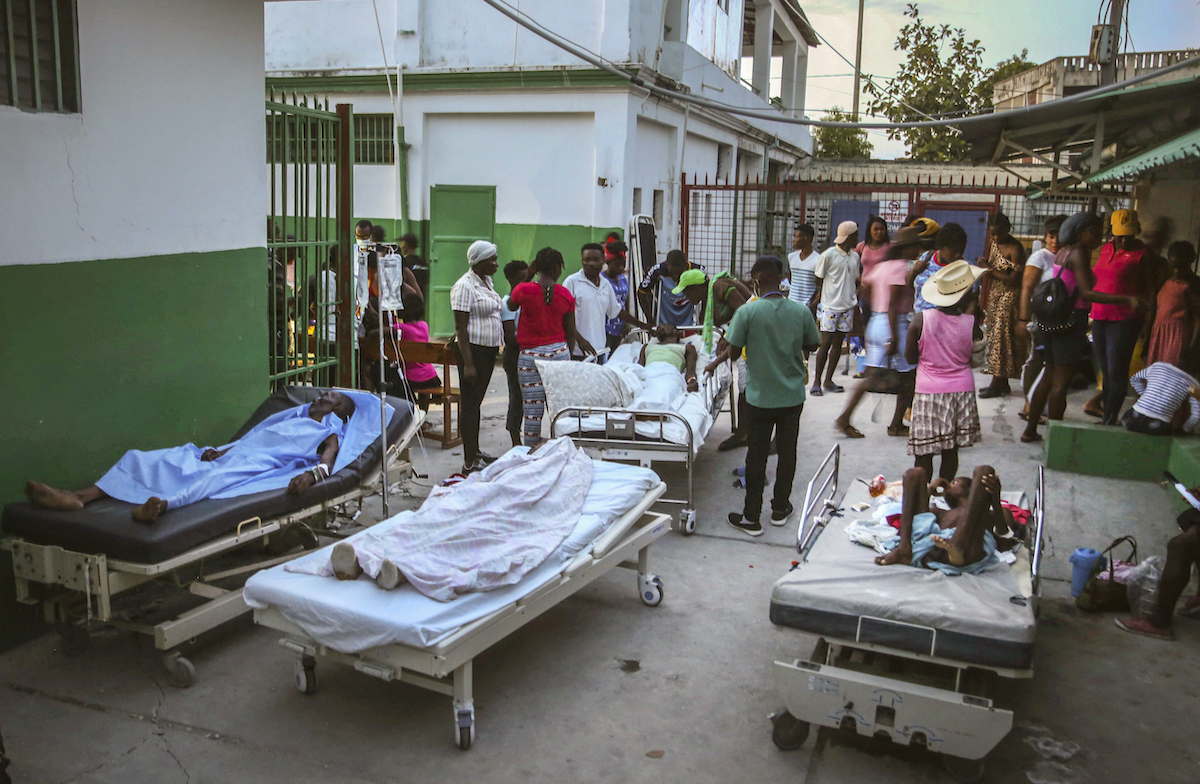

A man walks on a collapsed building in Saint-Louis-du-Sud, Haiti, Monday, August 16, 2021. A 7.2-magnitude earthquake struck the southwestern part of the hemisphere’s poorest nation on August 14. (AP Photo/Matias Delacroix)
By MARK STEVENSON and EVENS SANON, Associated Press
LES CAYES, Haiti (AP) — Rescuers and scrap metal scavengers dug into the floors of a collapsed hotel Monday in this quake-ravaged coastal town, where 15 bodies had already been extracted. Jean Moïse Fortunè, whose brother, the hotel owner, was killed in the quake, believed there were two or three people trapped in the rubble.
But based on the size of voids that workers cautiously peered into, perhaps a foot in depth, finding survivors appeared unlikely.
While residents carted away twisted heaps of scrap metal to earn some money, Dukens Sylvain was trying to detect signs of life.
“Those people are risking their lives for a bit of scrap,” the 37-year-old said of locals burrowing into the huge rubble pile. “I’m just worried about people’s lives.”
At a soccer pitch in Les Cayes, where families who had lost their homes tried to erect a bit of shade with sheets and sticks, people gathered for food being distributed off a truck.
The country’s Civil Protection Agency said 1,297 dead from the magnitude 7.2 earthquake had been counted by Sunday, a day after the temblor turned thousands of structures into rubble and set off frantic rescue efforts ahead of a potential deluge from an approaching tropical storm.
Saturday’s earthquake also left at least 5,700 people injured, with thousands more displaced from destroyed or damaged homes. After sundown Sunday, Les Cayes was darkened by intermittent blackouts, and many people slept outside, clutching small transistor radios tuned to news, terrified of the continuing aftershocks.
Meanwhile, efforts continued to get medical care to the injured.
Under Haiti’s burning heat, Jennie Auguste lay Sunday with a vacant stare on a flimsy foam mattress laid out on an airport tarmac. Auguste was injured in the chest, abdomen and arm when the roof of the store where she worked collapsed during Saturday’s quake.
She flashed the occasional grimace of pain while her sister or other helpful bystanders fanned her. With hospitals overwhelmed in Les Cayes, Auguste could only wait — for a hospital bed to open up, or a spot to become available on one of the small planes ferrying the injured to Haiti’s capital.
“There has been nothing. No help, nothing from the government,” Auguste’s sister, Bertrande, said as the death toll continued to grow.
The devastation could soon worsen with the coming of Tropical Depression Grace, which is predicted to reach Haiti on Monday night. The civil protection agency said strong winds, heavy rain, rough seas, landslides and flooding were expected.
Officials said more than 7,000 homes were destroyed and nearly 5,000 damaged from the quake, leaving some 30,000 families homeless. Hospitals, schools, offices and churches also were destroyed or badly damaged.
The quake, centered about 125 kilometers (80 miles) west of the capital of Port-au-Prince, nearly razed some towns and triggered landslides that hampered rescue efforts in a country that is the poorest in the Western Hemisphere. Haiti already was struggling with the coronavirus pandemic, gang violence, worsening poverty and the political uncertainty following the July 7 assassination of President Jovenel Moïse.
In a scene widely repeated across the quake zone, families salvaged their few belongings in Les Cayes and spent the night on a soccer field. People lined up to buy what little was available: bananas, avocados and water at a street market.
Workers tore through rubble of collapsed buildings with heavy machinery, shovels and picks.
Underlining the dire conditions, local officials had to negotiate with gangs in the seaside district of Martissant to allow two humanitarian convoys a day to pass through the area, the U.N. Office for the Coordination of Humanitarian Affairs reported. The agency called Haiti’s southern peninsula a “hot spot for gang-related violence,” where humanitarian workers have been repeatedly attacked.
The agency said the area has been “virtually unreachable” over the past two months because of road blocks and security concerns. Agency spokeswoman Anna Jefferys said the first convoy passed through Sunday with government and U.N. personnel. She added that the U.N.’s World Food Program plans to send in food supplies via trucks Tuesday.


People injured during the earthquake are treated in the hospital in Les Cayes, Haiti, Sunday, August 15, 2021. (AP Photo / Joseph Odelyn)
Prime Minister Ariel Henry has declared a one-month state of emergency for the whole country and said that first government aid convoys had started moving help to areas where towns were destroyed and hospitals were overwhelmed.
UNICEF Executive Director Henrietta Fore said humanitarian needs were acute, with many Haitians urgently needing health care, clean water and shelter. Children separated from their parents also needed protection, she said.
Referring to the 2010 earthquake that ravaged Haiti’s capital, killing tens of thousands, Fore said: “Little more than a decade on, Haiti is reeling once again. And this disaster coincides with political instability, rising gang violence, alarmingly high rates of malnutrition among children, and the COVID-19 pandemic, for which Haiti has received just 500,000 vaccine doses, despite requiring far more.”
The country of 11 million people received its first batch of U.S.-donated coronavirus vaccines only last month via a United Nations program for low-income countries.
Medical workers from across the region were scrambling to help as hospitals in Les Cayes started running out of space to perform surgeries.
“Basically, they need everything,” said Dr. Inobert Pierre, a pediatrician with the nonprofit Health Equity International, which oversees St. Boniface Hospital, about two hours from Les Cayes.
“Many of the patients have open wounds and they have been exposed to not-so-clean elements,” added Pierre, who visited two hospitals in Les Cayes — one with some 200 patients, the other with around 90. “We anticipate a lot of infections.”
Pierre’s medical team was taking some patients to St. Boniface to undergo surgery, but with just two ambulances, they could transport only four at a time.
Small planes from a private firm and the Florida-based missionary service Agape Flights landed at the Port-Au-Prince airport Sunday carrying about a half-dozen injured from the Les Cayes area. Young men with bandages and a woman were hoisted on stretchers to waiting Haitian Red Cross ambulances.
Working with USAID, the U.S. Coast Guard said a helicopter was transporting medical personnel from the Haitian capital to the quake zone and evacuating injured back to Port-au-Prince. Lt. Commander Jason Nieman, a spokesman, said other aircraft and ships were being sent.
Associated Press writers Collin Binkley in Boston, Trenton Daniel in New York and Regina Garcia Cano in Mexico City contributed to this report.


